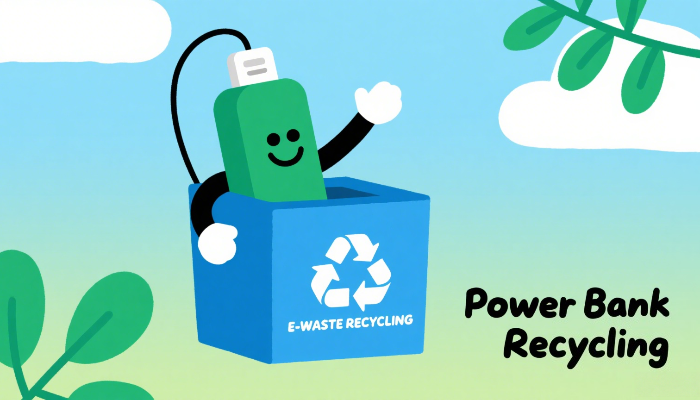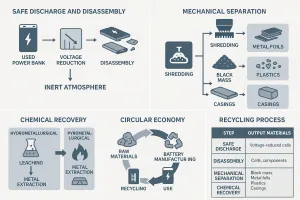Power banks have become indispensable in our digital lives, keeping our devices charged on the go. But what happens when these power banks reach the end of their life? Improper disposal can harm the environment, while recycling recovers valuable materials and reduces waste. This blog reveals the complete recycling journey of used power banks, focusing on the regeneration of battery materials, based on the latest international research and industry practices.
1. Safe Discharge and Disassembly: The First Crucial Step
Before recycling, used power banks must be completely discharged to prevent fire or explosion risks during handling. Common methods include controlled electrical discharge or immersion in saltwater to safely reduce battery voltage below hazardous levels.
Once discharged, the power bank casing is carefully opened, often in an inert nitrogen atmosphere to avoid oxidation. The internal lithium-ion cells are extracted for further processing, while metal casings and plastic components are separated for recycling1.
2. Mechanical Separation: Breaking Down the Battery
The extracted battery cells are shredded or crushed into smaller pieces to facilitate material separation. This process produces several output streams:
- Black mass: A granular mixture of cathode and anode materials rich in valuable metals.
- Copper and aluminum foils: Current collectors that held active materials.
- Separators and plastics: Thin films and polymer components.
- Steel casings and terminals.
Magnetic and density-based sorting techniques then separate metals like iron, copper, and aluminum, improving purity for downstream recovery.
3. Chemical and Thermal Recovery: Extracting Valuable Metals
The heart of battery recycling lies in recovering metals such as lithium, cobalt, nickel, and manganese from the black mass. Two main approaches are widely used:
- Hydrometallurgy (Wet Chemical Recovery): The black mass is leached with acids, dissolving metals into solution. Subsequent purification steps (solvent extraction, precipitation) isolate individual metals for reuse.
- Pyrometallurgy (Thermal Recovery): High-temperature treatment decomposes organics and separates metals by oxidation and reduction reactions.
Emerging bioleaching methods use microorganisms to selectively extract metals, offering greener alternatives currently under research.
4. Refining and Material Reuse: Closing the Loop
Recovered metal salts are chemically refined to produce battery-grade precursors. These materials are then used to manufacture new cathodes and anodes, enabling a closed-loop recycling system that reduces reliance on virgin mining.
Aluminum, copper foils, and plastics are cleaned and recycled separately, contributing to a circular economy2.
5. Environmental and Safety Measures
Throughout recycling, strict controls capture hazardous electrolyte vapors and prevent toxic emissions. Automated, sealed systems minimize worker exposure and environmental impact, ensuring compliance with international standards such as the Responsible Recycling (R2) and Basel Action Network (BAN).
Why Recycling Power Banks Matters
Recycling used power banks:
- Recovers valuable metals, reducing the need for environmentally damaging mining.
- Prevents toxic waste from contaminating soil and water.
- Supports sustainable battery manufacturing, essential as demand for lithium-ion batteries soars3.
Summary Diagram: The Complete Recycling Process
| Step | Description | Output Materials |
|---|---|---|
| 1. Safe Discharge | Controlled voltage reduction to prevent hazards | Discharged cells ready for dismantling |
| 2. Mechanical Separation | Shredding and sorting into black mass, foils, plastics4 | Black mass, Cu/Al foils, plastics, steel |
| 3. Chemical/Thermal Recovery | Acid leaching or high-temp treatment to extract metals | Lithium, cobalt, nickel, manganese salts |
| 4. Refining & Reuse | Purification and synthesis of battery precursors | Battery-grade materials for new batteries |
By understanding and supporting these recycling processes, consumers and industries alike can contribute to a greener, more sustainable future. Next time your power bank reaches the end of its life, remember: recycling it responsibly helps power tomorrow’s technologies.






 No products in the cart.
No products in the cart.